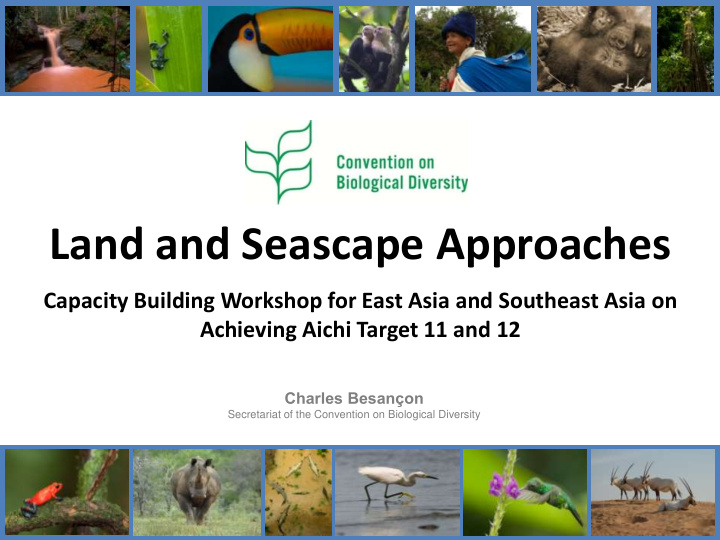



Land and Seascape Approaches Capacity Building Workshop for East Asia and Southeast Asia on Achieving Aichi Target 11 and 12 Charles Besançon Secretariat of the Convention on Biological Diversity
Transboundary Conservation supported by international policy frameworks • Convention on Biological Diversity • Convention on Migratory Species • UNESCO World Heritage Sites • UNESCO Man and Biosphere Reserves • Ramsar Convention on Wetlands • ASEAN Heritage Parks
Convention on Biological Diversity • CBD COP 8 - POWPA Goals – 1.2 To integrate protected areas into broader land- and seascapes and sectors so as to maintain ecological structure and function – 1.3 To establish and strengthen regional networks, transboundary protected areas (TBPAs) and collaboration between neighboring protected areas across national boundaries
Aichi Biodiversity Target 11 By 2020, at least 17 per cent of terrestrial and inland water areas, and 10 per cent of coastal and marine areas, especially areas of particular importance for biodiversity and ecosystem services, are conserved through effectively and equitably managed, ecologically representative and well connected systems of protected areas and other effective area-based conservation measures, and integrated into the wider landscapes and seascapes .
What is the Convention on Migratory Species (CMS)? A framework for countries to conserve migratory species throughout their entire range Migratory species : An entire population or any geographically separate part of the population of any species, significant number of whose members cyclically and predictably cross one or more national jurisdictional boundaries . Two Appendices I. Migratory species threatened with II. Migratory species whose conservation extinction requires international Agreements
CMS Agreements & MOUs Legally Binding Agreements Wadden Sea ACAP ACCOBAMS AEWA ASCOBANS EUROBATS Gorilla Seals Non- Legally Binding Memoranda of Understanding (MOU) Aquatic Bukhara Deer Dugong Grassland Birds Great High Andean IOSEA Warbler of South America Bustard Flamingo Marine Mediterranean Raptors Ruddy Headed Saiga Sharks Pacific Turtles Africa Monk Seal Goose Antelope Cetaceans West African South Andean Western African Siberian Slender- Elephants Huemul Aquatic Mammals Crane billed Curlew
Memorandum of Understanding on the Conservation of Migratory Sharks (Sharks MOU) • CMS services this global agreement among governments • Under the MOU, a Conservation Plan was adopted to, among other things, ensure that directed and non-directed fisheries are sustainable and protect critical habitats, migration corridors and critical life stages of sharks • The MOU calls for cooperation among governments, fishing industries, NGOs, local communities and scientists Key figures • 7 species of sharks; • All Range States, Signed by 39 States Signatories to the Sharks MOU
Indian Ocean South-East Asian Marine Turtle Memorandum of Understanding (IOSEA) • CMS services this regional agreement among governments • Under the MOU, a Conservation and Management Plan was adopted to reduce turtle mortality, protect their habitat and promote implementation and monitoring • A Network of Important Sites for turtles was established for their long-term conservation and to formally recognise their socio-economic importance Key figures • 6 species of turtles; • 44 Range States, Signed by 33 States
Central Asian Mammal Initiative (CAMI) • One of the world’s last mammal migration hotspots • CMS provides umbrella for international cooperation and framework to coordinate conservation activities in the region and coherently address major threats • CAMI focuses on single species and on common issues including removal of barriers to migration and building of transboundary ecological networks Key figures • 15 species: 13 ungulates, 2 big cats • 14 Range States (9 CMS Parties) • Programme of Work 2014 – 2020
Achieving POWPA Goal 1.2 and 1.3, Target 11 elements of connectivity and land and seascape approaches • Development of biodiversity corridors • Transboundary collaboration in protected areas and OECMs • Marine spatial planning • Integrated land management
Group work Objectives 1. Collect information on status, gaps and opportunities on connectivity and transboundary conservation 2. Collect information on current transboundary collaboration projects 3. Identify opportunities for future collaboration across international boundaries
Group Work Complete table for: Elements of Status Gaps Opportunities Targets 11 and 12 Connectivity and Corridors Integration into wider land and seascapes
Update table and new ones
Thank you!
Recommend
More recommend